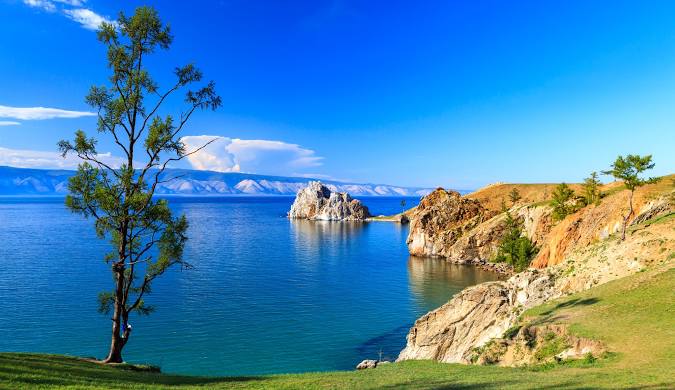Lake Baikal: Siberia – Russia
A Comprehensive Research Travel Guide

Introduction
Lake Baikal, the stunning “blue pearl” of Russia, stands as one of the most remarkable natural wonders on Earth. Located in southeastern Siberia near the Mongolian border, this crescent-shaped lake is the world’s deepest (1,700 meters) and oldest (25 million years) freshwater lake, containing an astonishing 20% of the world’s unfrozen freshwater reserves【3】.
Designated as a UNESCO World Heritage Site, Lake Baikal is renowned for its crystal-clear waters that mirror Siberia’s wild beauty and its unique ecosystem, earning it the nickname “Galapagos of Russia”【23】. This comprehensive guide explores the diverse attractions, cultural experiences, and practical information for travelers seeking to discover this magnificent natural treasure, from thrilling winter adventures across its frozen surface to serene summer cruises, traditional Buryat cultural immersion, and encounters with endemic wildlife in one of the world’s most exceptional destinations.
Geographical Significance and Natural Wonders
The Jewel of Siberia: Facts and Figures
- Length: 636 km from north to south
- Maximum Depth: 1,637 meters (deepest lake on Earth)【2】
- Formation: A rift valley that continues expanding by ~2 cm per year【6】
- Surface Area: 3.15 million hectares, spanning Irkutsk Oblast (west) & Buryatia (east)【23】
- Age: 25 million years, defying the typical lifespan of lakes (10,000-15,000 years)【6】【8】
Unique Ecosystem and Wildlife
Lake Baikal’s isolation and age have fostered one of the world’s richest and most unusual freshwater ecosystems, making it invaluable for evolutionary science【3】.
- Baikal Seal (Nerpa): The world’s only freshwater seal, observable at Ushkan Islands【5】【7】.
- Omul Fish: A prized delicacy in local cuisine【5】.
- Over 1,500 endemic species, many not found anywhere else【3】.
UNESCO Designation: Recognized for its extraordinary biodiversity, Lake Baikal is a living laboratory for evolutionary studies【3】.
Seasonal Transformations
Lake Baikal undergoes dramatic seasonal changes, offering different experiences throughout the year:
Winter (December – April)
- Frozen landscape with clear ice patterns【6】.
- Activities: Ice fishing, dog sledding, skating, and winter photography.
Summer (June – September)
- Warmer temperatures allow for swimming, hiking, and boat excursions【12】.
- Lush taiga forests and wildlife spotting.
Spring & Autumn
- Fewer tourists, offering a peaceful experience【6】.
- Autumn features stunning foliage; spring sees rivers thawing.
Top Destinations Around Lake Baikal
Irkutsk: The Gateway to Baikal
Often called the “Paris of Siberia”, Irkutsk is the main access point to Lake Baikal【24】.
- Features wooden architecture, Russian Orthodox churches, and cozy Siberian cafes.
- 3-hour tours cover key landmarks and the Angara River embankment【4】.
Listvyanka Village: Tourist Hub
- Closest Baikal settlement to Irkutsk (1-hour drive)【4】.
- Attractions: Baikal Museum, Chersky Stone viewpoint, Taltsy Open-Air Museum【4】.
- Local Fish Market: Try smoked omul and other Baikal specialties【4】.
Olkhon Island: The Heart of Baikal
- The largest island in the lake, considered sacred by Buryat people【47】.
- Famous sites: Shaman Rock (Burkhan Cape), Cape Khoboy, Three Brothers Rock【4】.
- UAZ 4WD tours take visitors through dramatic landscapes【4】.
Activities and Experiences
Water-Based Adventures
- Boat Tours: Fast boats like Kometa connect major destinations【4】.
- Fishing Expeditions: Catch and cook Baikal’s endemic fish【5】.
- Diving: Explore Baikal’s crystal-clear underwater ecosystem【16】.
Winter Adventures on Frozen Baikal
- Dog Sledding: Ride across the ice【6】.
- Ice Fishing: Drill holes in thick ice for fishing【6】.
- Ice Skating & Hovercraft Tours: Traverse vast frozen expanses【6】.
Hiking & Trekking
- Great Baikal Trail (GBT): A 24 km scenic coastal path【1】.
- Khamar-Daban Mountain Range: Alpine tundra and glaciers【8】.
- Cape Khoboy Trek: Spectacular cliffside views【4】.
Conservation & Responsible Tourism
Environmental Challenges
- Pollution from industries & settlements【3】.
- Tourism impact on fragile ecosystems【5】.
- Climate change affecting ice formation【3】.
How to Help
- Respect nature: Stick to marked trails & avoid littering【15】.
- Support eco-friendly operators.
- Visit educational sites like the Baikal Museum【4】.
Conclusion
Lake Baikal stands as one of Earth’s most extraordinary natural treasures, offering visitors breathtaking landscapes, rare wildlife, and rich cultural heritage. Whether exploring its frozen surface in winter or cruising its tranquil waters in summer, a journey to Baikal is an experience like no other.
Travel responsibly and discover why Baikal is called the Pearl of Siberia.
References
- UNESCO World Heritage Site – Lake Baikal
- Lake Baikal Travel Guide – 56th Parallel
- Lake Baikal Information – UNESCO
- Tourism in Lake Baikal – 56th Parallel
- Omul Fish & Baikal Cuisine – Travel Triangle
- Baikal Ice Formations – Travel Triangle
- Legends of Baikal – Russia Discovery
- Baikal Trekking Guide – Advantour
- Listvyanka Village Guide
- Olkhon Island Travel Guide
Xplore Heaven
- Kaas Plateau Travel Guide 2026: Best Time to Visit, Bloom Season, How to Reach & FAQs
- What Is the Quirimbas Archipelago Mozambique Known For? Complete Travel & Nature Guide
- Is Angola Safe to Travel in 2025? Your Essential Guide to Health, Crime, and Landmine Safety
- What Animals Live in Bale Mountains Ethiopia? Complete Wildlife Guide
- What to Do in Damaraland — Complete Travel Guide for First-Timers
A beautiful location in India, read more like this https://xploreheaven.com/chikhaldara/
